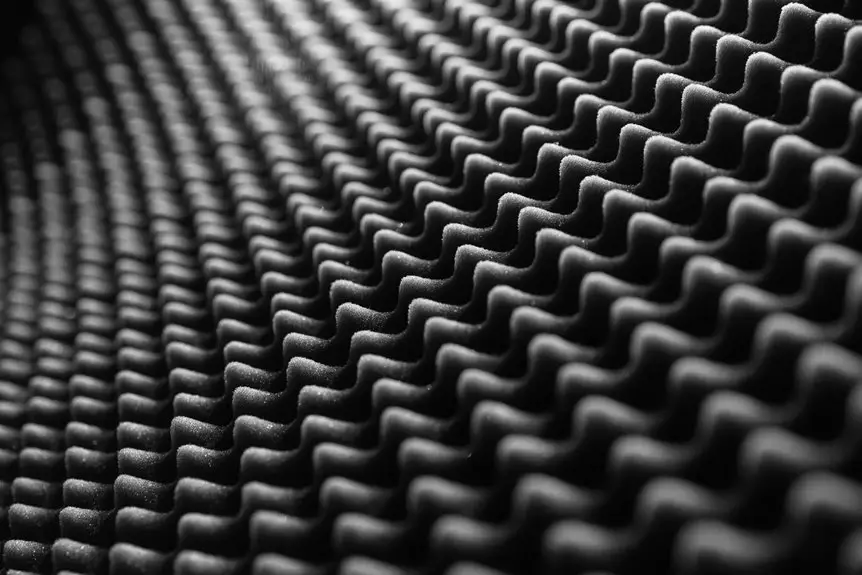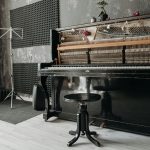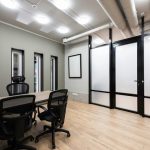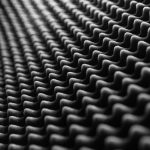Acoustic foam wedges are great for quick sound treatment, effectively absorbing high frequencies and reducing echoes. They’re easy to install and require little maintenance. On the other hand, DIY fabric panels offer a customizable look and can absorb a wider range of frequencies but may require more effort to install and maintain. Your choice boils down to your budget and aesthetic preferences. If you want to know more about the pros and cons of each option, keep exploring!
Table of Contents
Key Takeaways
- Acoustic foam wedges effectively absorb high frequencies and reduce echoes, providing quick sound treatment results.
- DIY fabric panels can offer a customizable look but may require additional materials for optimal sound absorption.
- Installation of acoustic foam is simpler and quicker compared to the more complex setup of DIY fabric panels.
- Acoustic foam is lightweight, allowing for easy rearrangement, while DIY fabric panels are heavier and less portable.
- Cost-wise, acoustic foam may have lower initial costs, but DIY options can save money in the long run despite more effort.
Understanding Acoustic Foam Wedges
Acoustic foam wedges are essential tools for anyone looking to improve sound quality in a room. These wedges absorb sound waves, reducing echoes and enhancing clarity.
When you place them strategically on walls or ceilings, you’ll notice a significant difference in your audio experience. They’re particularly effective in home studios, offices, or any space where clear sound is vital.
You don’t need to worry about complicated installation; simply peel and stick or use adhesive spray. Plus, they come in various colors and shapes, allowing you to match your decor.
Exploring DIY Fabric Panels
While you might think acoustic foam is the only option for sound treatment, DIY fabric panels can be an effective and aesthetically pleasing alternative.
Creating your own panels allows you to customize the look and feel of your space, matching your decor while improving acoustics. You can choose fabrics that complement your style, whether it’s modern, rustic, or eclectic.
Plus, building these panels is straightforward; you’ll just need some wood, insulation material, and fabric. Once assembled, you can hang them strategically in your room to reduce sound reflections.
Unlike foam, fabric panels can also absorb a wider range of frequencies, enhancing audio clarity. With a little creativity, you can transform your space into a stylish and acoustically optimized environment.
Cost Comparison: Acoustic Foam vs. DIY Panels
When considering sound treatment options, the cost can play a significant role in your decision-making process.
Acoustic foam wedges typically range from $1 to $3 per square foot, depending on thickness and quality. This can add up quickly, especially if you need a large area covered.
Acoustic foam wedges can cost between $1 to $3 per square foot, making large area coverage potentially expensive.
On the other hand, DIY fabric panels can be more budget-friendly. You can often source materials like fabric and insulation for around $0.50 to $1 per square foot.
While DIY panels may require more time and effort, they can save you money if you’re willing to get hands-on.
Ultimately, your choice will depend on your budget, available time, and aesthetic preferences. Balancing cost with effectiveness is key in your decision.
Effectiveness in Sound Treatment
When it comes to sound treatment, you’ll want to contemplate the sound absorption properties of both acoustic foam wedges and DIY fabric panels.
Each option covers different frequency ranges and can affect how your space sounds.
Plus, think about how easy they’re to install and how they look in your environment.
Sound Absorption Properties
Acoustic foam wedges and DIY fabric panels both aim to improve sound quality, but their effectiveness in sound treatment varies considerably.
Foam wedges are specifically designed to absorb sound, reducing echoes and reverberations effectively. Their unique structure traps sound waves, helping to create a more balanced acoustic environment.
On the other hand, DIY fabric panels can also absorb sound, but their performance heavily depends on the materials and thickness you choose. While they can be aesthetically pleasing, they may not offer the same level of absorption as foam wedges.
If you’re looking for quick and reliable results, acoustic foam might be your best bet. However, well-constructed fabric panels can still contribute positively to your sound treatment goals.
Frequency Range Coverage
Understanding frequency range coverage is essential in choosing the right sound treatment solution. When evaluating acoustic foam wedges versus DIY fabric panels, consider how well each option handles different frequencies.
- Low Frequencies: Acoustic foam typically struggles to absorb lower frequencies, while thicker fabric panels can provide better coverage, especially when layered.
- Mid Frequencies: Both options perform reasonably well here, but foam may offer a slight edge due to its design, which targets these frequencies effectively.
- High Frequencies: Acoustic foam excels at absorbing high frequencies, reducing echo and reverb. DIY fabric panels can also help but may not be as effective without additional soundproofing materials.
Ultimately, your choice should align with the specific frequency challenges in your space.
Installation and Aesthetics
While considering sound treatment options, installation and aesthetics play a crucial role in their overall effectiveness. Acoustic foam wedges are generally easier to install; you can simply peel and stick them to your walls. They provide a clean, professional look, enhancing the room’s appearance without overwhelming it. On the other hand, DIY fabric panels can be more time-consuming to make but allow for customization in design, fabric, and color. This can create a unique aesthetic that reflects your personality.
Here’s a quick comparison:
| Aspect | Acoustic Foam Wedges | DIY Fabric Panels |
|---|---|---|
| Installation Ease | Easy | Moderate |
| Aesthetic Appeal | Professional | Customizable |
| Cost | Mid-range | Varies |
Aesthetic Considerations
When you’re choosing between acoustic foam wedges and DIY fabric panels, aesthetics play an essential role in your decision.
You want your soundproofing solution to blend seamlessly with your space while effectively reducing noise. Consider these factors:
- Color Options: Acoustic foam typically comes in a limited range of colors, while DIY fabric panels allow you to choose any fabric that matches your decor.
- Texture: Foam often has a spongy, industrial look, whereas fabric panels can add warmth and a more sophisticated feel to your room.
- Design Flexibility: DIY panels can be customized in shape and size to fit specific areas, letting you create a unique design that reflects your personal style.
Ultimately, your choice should enhance your room’s overall vibe.
Installation Process and Maintenance
When it comes to installation, you’ll find that acoustic foam wedges are typically easier to put up compared to DIY fabric panels.
However, maintenance can vary considerably between the two options, so it’s crucial to contemplate how much upkeep you’re willing to manage.
Let’s explore the differences in ease of installation and the maintenance requirements for each choice.
Installation Ease Comparison
Many people find that acoustic foam wedges are easier to install than DIY fabric panels. If you’re looking for a straightforward solution, acoustic foam offers a hassle-free experience.
Here’s what makes the installation process simpler:
- Pre-cut Sizes: Acoustic foam typically comes in various pre-cut sizes, allowing you to choose the perfect fit for your space without any cutting or measuring.
- Adhesive Backing: Many foam wedges feature adhesive backing, so you can peel and stick them directly onto your walls, eliminating the need for additional tools.
- Lightweight Material: The lightweight nature of foam means you won’t struggle with heavy materials, making it easy to reposition if needed.
In contrast, fabric panels often require more effort and precision, adding to your installation time.
Maintenance Requirements Overview
While both acoustic foam wedges and DIY fabric panels serve the purpose of sound absorption, their maintenance requirements differ markedly. Acoustic foam is relatively low-maintenance; just wipe it down occasionally with a damp cloth to remove dust. On the other hand, DIY fabric panels may require more attention, such as periodic washing or vacuuming to keep them clean and looking fresh.
Here’s a quick comparison:
| Acoustic Foam Wedges | DIY Fabric Panels |
|---|---|
| Wipe with a damp cloth | Vacuum or wash fabric |
| No special treatment required | May need re-stretching |
| Lightweight and easy to move | Heavier and more complex installation |
Understanding these maintenance needs can help you make an informed choice for your space.
Frequently Asked Questions
Can Acoustic Foam Wedges Be Used Outdoors?
You shouldn’t use acoustic foam wedges outdoors. They aren’t designed for weather exposure and can degrade quickly in sunlight or moisture. If you need outdoor soundproofing, look for materials specifically made to withstand the elements.
How Long Do DIY Fabric Panels Typically Last?
DIY fabric panels typically last several years, depending on materials and usage. You’ll find that well-constructed panels resist wear and tear, while regular maintenance enhances durability, ensuring they continue to provide effective sound absorption.
Are There Specific Brands of Acoustic Foam Recommended?
When choosing acoustic foam, brands like Auralex, Foam Factory, and Soundproof Cow are highly recommended. They offer various shapes and densities that effectively reduce sound reflections, helping you achieve better acoustics in your space.
Can I Paint DIY Fabric Panels for Customization?
You can easily paint DIY fabric panels for a personalized touch. Just like a blank canvas, your creativity shapes the outcome. Use fabric paint for best results; it’ll help maintain texture and acoustic properties.
Do Acoustic Foam Wedges Absorb Low Frequencies Effectively?
Acoustic foam wedges aren’t the best at absorbing low frequencies. While they excel at mid to high frequencies, you’ll need additional materials, like bass traps or thicker panels, for effective low-frequency absorption in your space.




